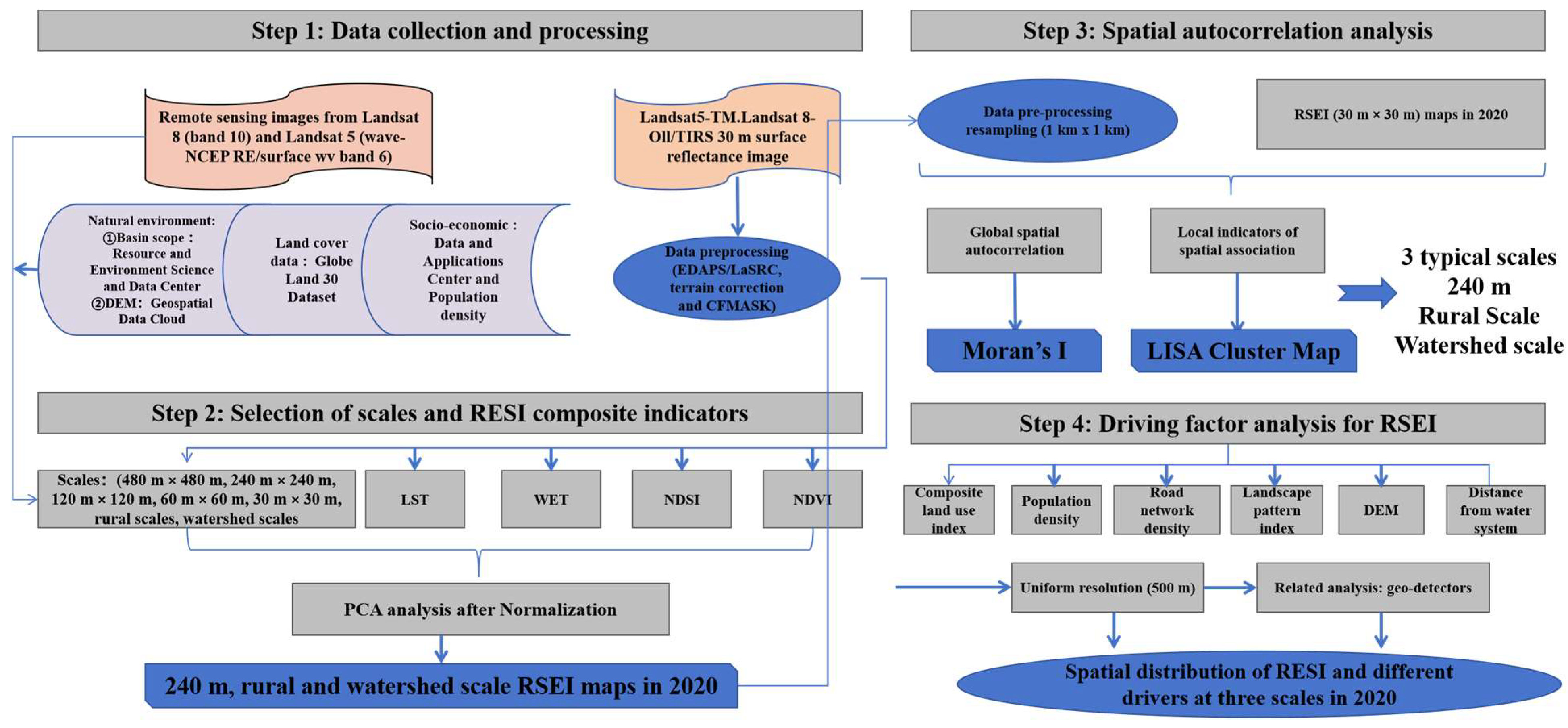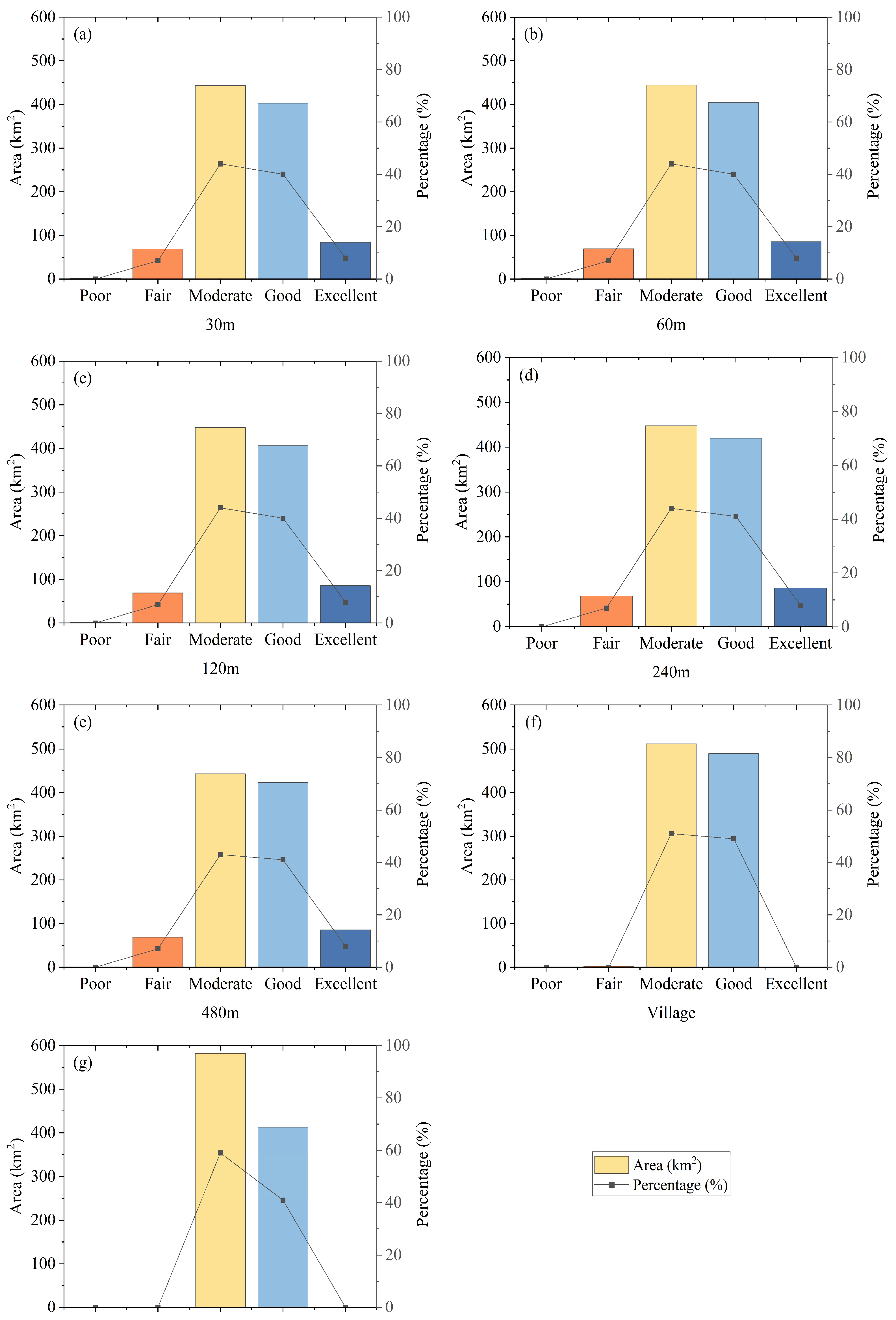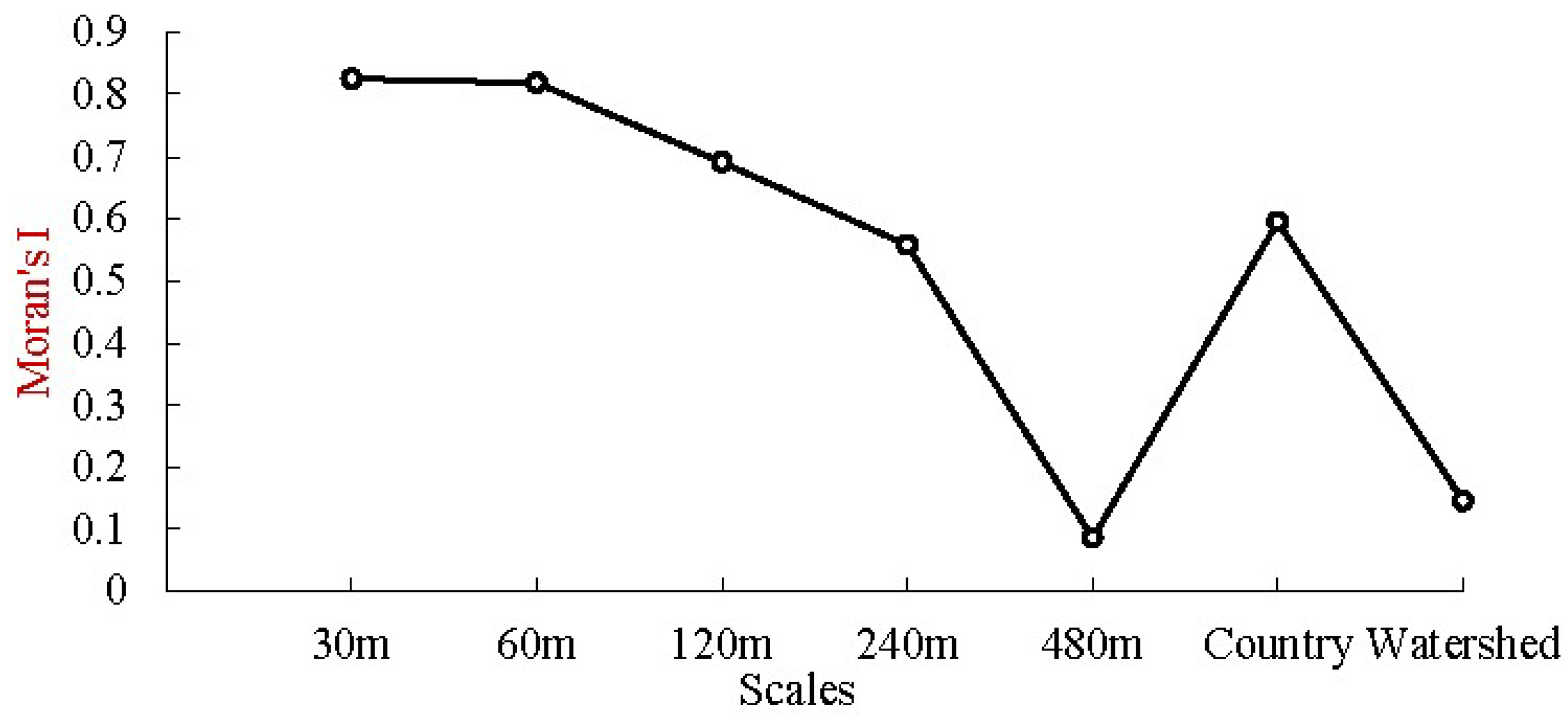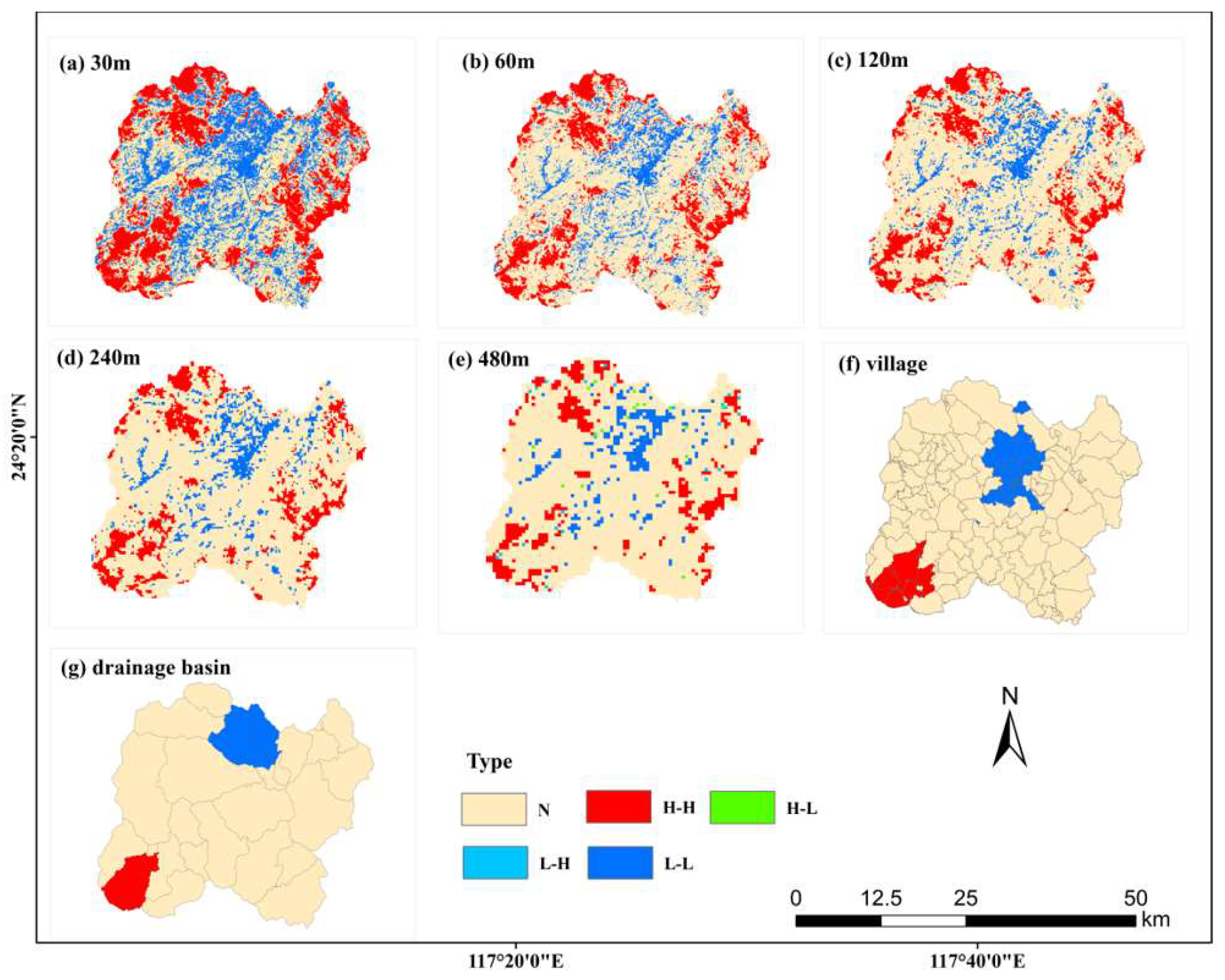Multi-Scale Remote Sensing Assessment of Ecological Environment Quality and Its Driving Factors in Watersheds: A Case Study of Huashan Creek Watershed in China
Abstract
:1. Introduction
2. Materials and Methods
2.1. Study Area
2.2. Data Collection and Processing
2.2.1. Options for Different Scales
2.2.2. RSEI
2.2.3. Characterization of RSEI
2.2.4. Spatial Autocorrelation Analyses
- (1)
- Global spatial autocorrelation (Global Moran’s I: MI)
- (2)
- Local spatial autocorrelation (Local Moran’s I: LI)
2.2.5. Driver Analysis
- (1)
- Driver selection
- (2)
- GWR
3. Result
3.1. Patterns of Spatial Differentiation in Ecosystem Quality at Multiple Scales
3.2. Spatially Dependent Characterization of Ecosystem Quality at Multiple Scales
3.2.1. Global Spatial Correlation Multi-Scale Spatial Response Characteristics of Remotely Sensed Ecological Quality
3.2.2. Local Spatial Correlation Multi-Scale Spatial Response Characteristics of Remotely Sensed Ecological Quality
3.3. Response and Difference Analysis of Multiscale Drivers of Remotely Sensed Ecological Quality
3.3.1. Local Spatial Correlation: Multi-Scale Spatial Response Characteristics of Remotely Sensed Ecological Quality
3.3.2. Analysis of Spatial Differences in Multi-Scale Remote Sensing Ecosystem Quality Drivers Based on GWR
4. Discussion
4.1. RSEI Response to Spatial Scales
4.2. Response of RSEI Drivers to Spatial Scales
4.2.1. Key Drivers of RSEI
4.2.2. Driven Response of RSEI at Different Scales
4.3. Selection of Scale
4.4. Policy Implications
4.5. Limitations and Prospects
5. Conclusions
- (1)
- Global autocorrelation revealed that the size and area information associated with the RSEI gradually transitioned from a complex-detailed to a more intuitive and clearer pattern as the scale resolution decreased. The fusion analysis of 240 m unit, rural, and watershed scales can not only encompass the rich information on RSEI spatial differences but can also provide data support and a more intuitive scientific assessment of the impacts of land use and water quality changes;
- (2)
- Local autocorrelation showed that RSEI exhibits relatively apparent spatial aggregation characteristics at different scales. The RSEI of the Huashan Creek watershed in 2020 was generally moderate. Areas with poor RSEI were concentrated in the built-up areas and riparian zones of the towns and cities in the central plain area. In contrast, areas with higher RSEI were concentrated in the western mountains with greater vegetation cover;
- (3)
- Using PCA, we identified five key factors affecting RSEI: DEM, POP, DisRoad, DisWater, and PD. Moreover, using GWR and controlling for confounding geographic factors, we found that human activities had a significant effect on environmental quality. The population was found to have a significant effect at all three scales. Elevation was significant at the administrative village level, while the patch landscape index significantly affected the grid and catchment scales. Complex interactions between natural features, land use, and socio-economic factors exacerbate the fragmentation of landscape patches, amplifying their effects on ecosystem quality in a non-linear manner. These complex interactions highlight the critical role of elevation, population, proximity to roads, and proximity to water bodies in shaping the ecological integrity of the region.
Supplementary Materials
Author Contributions
Funding
Data Availability Statement
Conflicts of Interest
References
- Venter, O.; Sanderson, E.W.; Magrach, A.; Allan, J.R.; Beher, J.; Jones, K.R.; Possingham, H.P.; Laurance, W.F.; Wood, P.; Fekete, B.M. Sixteen years of change in the global terrestrial human footprint and implications for biodiversity conservation. Nat. Commun. 2016, 7, 12558. [Google Scholar] [CrossRef] [PubMed]
- Costanza, R.; d’Arge, R.; De Groot, R.; Farber, S.; Grasso, M.; Hannon, B.; Limburg, K.; Naeem, S.; O’neill, R.V.; Paruelo, J. The value of the world’s ecosystem services and natural capital. Nature 1997, 387, 253–260. [Google Scholar] [CrossRef]
- Liu, Z.; Wu, R.; Chen, Y.; Fang, C.; Wang, S. Factors of ecosystem service values in a fast-developing region in China: Insights from the joint impacts of human activities and natural conditions. J. Clean. Prod. 2021, 297, 126588. [Google Scholar] [CrossRef]
- McDonnell, M.J.; MacGregor-Fors, I. The ecological future of cities. Science 2016, 352, 936–938. [Google Scholar] [CrossRef] [PubMed]
- Lin, J.; Huang, J.; Hadjikakou, M.; Huang, Y.; Li, K.; Bryan, B.A. Reframing water-related ecosystem services flows. Ecosyst. Serv. 2021, 50, 101306. [Google Scholar] [CrossRef]
- Cai, J. Study on water environmental protection countermeasures of Huashan Stream in Pinghe County. Leather Manuf. Environ. Technol. 2021, 2, 18–20. [Google Scholar]
- Huang, W.; Chen, G.; Hu, C. Real time regional soil erosion evaluation based on RS technique—Case study in Huashanxi Watershed, Fujian Province. Chin. J. Geol. Hazard Contr. 2003, 14, 118–120, 126. [Google Scholar]
- Han, S. Optimal allocation of water resources in Pinghe County and its surrounding towns. Hydr. Sci. Technol. 2023, 1, 14–17. [Google Scholar]
- Wen, X.; Lin, Z.; Tang, F. Remote sensing analysis of ecological change caused by construction of the new island city: Pingtan Comprehensive Experimental Zone, Fujian Province. J. Appl. Ecol. 2015, 26, 541–547. [Google Scholar]
- Wang, G.Y.; Mang, S.; Cai, H.S.; Liu, S.R.; Zhang, Z.Q.; Wang, L.G.; Innes, J.L. Integrated watershed management: Evolution, development and emerging trends. J. For. Res. 2016, 27, 967–994. [Google Scholar] [CrossRef]
- Song, H.M.; Xue, L. Dynamic monitoring and analysis of ecological environment in Weinan City, Northwest China based on RSEI model. J. Appl. Ecol. 2016, 27, 3913–3919. [Google Scholar]
- Wu, Z.; Wang, M.; Chen, S.; Zou, D. Monitoring and evaluation of ecological environments spatio-temporal variation in mine based on RSEI a case of Yongding mine. Ecol. Sci. 2016, 35, 200. [Google Scholar]
- Zhang, H.; Du, P.; Luo, J.; Li, E. Ecological change analysis of Nanjing city based on remote sensing ecological index. Geosp. Inf. 2017, 15, 58–62. [Google Scholar]
- Xu, M.; Chen, C.; Deng, X. Systematic analysis of the coordination degree of China’s economy-ecological environment system and its influencing factor. Environ. Sci. Pollut. Res. 2019, 26, 29722–29735. [Google Scholar] [CrossRef] [PubMed]
- Xiao, W.; Guo, J.; He, T.; Lei, K.; Deng, X. Assessing the ecological impacts of opencast coal mining in Qinghai-Tibet Plateau-a case study in Muli coal field, China. Ecol. Indic. 2023, 153, 110454. [Google Scholar] [CrossRef]
- Sishodia, R.P.; Ray, R.L.; Singh, S.K. Applications of remote sensing in precision agriculture: A review. Remote Sens. 2020, 12, 3136. [Google Scholar] [CrossRef]
- Wang, S.; Zhang, X.-X.; Zhu, T.; Yang, W.; Zhao, J. Assessment of ecological environment quality in the Changbai Mountain Nature Reserve based on remote sensing technology. Prog. Geogr. 2016, 35, 1269–1278. [Google Scholar]
- Liu, C.; Wu, X.; Wang, L. Analysis on land ecological security change and affect factors using RS and GWR in the Danjiangkou Reservoir area, China. Appl. Geogr. 2019, 105, 1–14. [Google Scholar] [CrossRef]
- Zhang, R.; Li, C.K.; Yao, S.; Li, W. Study on the change factors of construction land in Taiyuan by integrating geographic detector and geographically weighted regression. Bull. Surv. Mapp. 2022, 5, 106–109, 119. [Google Scholar]
- Xu, H.; Wang, M.; Shi, T.; Guan, H.; Fang, C.; Lin, Z. Prediction of ecological effects of potential population and impervious surface increases using a remote sensing based ecological index (RSEI). Ecol. Indic. 2018, 93, 730–740. [Google Scholar] [CrossRef]
- Gao, P.; Kasimu, A.; Zhao, Y.; Lin, B.; Chai, J.; Ruzi, T.; Zhao, H. Evaluation of the temporal and spatial changes of ecological quality in the Hami oasis based on RSEI. Sustainability 2020, 12, 7716. [Google Scholar] [CrossRef]
- Hang, X.; Li, Y.; Luo, X.; Xu, M.; Han, X. Assessing the ecological quality of Nanjing during its urbanization process by using satellite, meteorological, and socioeconomic data. J. Meteorolog. Res. 2020, 34, 280–293. [Google Scholar] [CrossRef]
- Xiong, Y.; Xu, W.; Lu, N.; Huang, S.; Wu, C.; Wang, L.; Dai, F.; Kou, W. Assessment of spatial–temporal changes of ecological environment quality based on RSEI and GEE: A case study in Erhai Lake Basin, Yunnan province, China. Ecol. Indic. 2021, 125, 107518. [Google Scholar] [CrossRef]
- Yang, C.; Zhang, C.; Li, Q.; Liu, H.; Gao, W.; Shi, T.; Liu, X.; Wu, G. Rapid urbanization and policy variation greatly drive ecological quality evolution in Guangdong-Hong Kong-Macau Greater Bay Area of China: A remote sensing perspective. Ecol. Indic. 2020, 115, 106373. [Google Scholar] [CrossRef]
- Zhang, T.; Yang, R.; Yang, Y.; Li, L.; Chen, L. Assessing the urban eco-environmental quality by the remote-sensing ecological index: Application to Tianjin, North China. ISPRS Int. J. Geo-Inf. 2021, 10, 475. [Google Scholar] [CrossRef]
- Zhang, H.; Ouyang, Z.; Zheng, H. Spatial scale characteristics of ecosystem services. Chin. J. Ecol. 2007, 26, 1432–1437. [Google Scholar]
- Fu, B.; Zhou, G.; Bai, Y.; Song, C.; Liu, J.; Zhang, H.; Lv, Y.; Zheng, H.; Xie, G. The Main Terrestrial Ecosystem Services and Ecological Security in China. Adv. Earth Sci. 2009, 24, 571–576. [Google Scholar]
- Jiang, F.; Zhang, Y.; Li, J.; Sun, Z. Research on remote sensing ecological environmental assessment method optimized by regional scale. Environ. Sci. Pollut. Res. Int. 2021, 28, 68174–68187. [Google Scholar] [CrossRef]
- Geng, J.; Yu, K.; Xie, Z.; Zhao, G.; Ai, J.; Yang, L.; Yang, H.; Liu, J. Analysis of spatiotemporal variation and drivers of ecological quality in Fuzhou based on RSEI. Remote Sens. 2022, 14, 4900. [Google Scholar] [CrossRef]
- Jin, Y.; Ge, Y.; Wang, J.; Heuvelink, G.B.M.; Wang, L. Geographically weighted area-to-point regression kriging for spatial downscaling in remote sensing. Remote Sens. 2018, 10, 579. [Google Scholar] [CrossRef]
- Huang, Y.; Huang, J.; Ervinia, A.; Duan, S.; Kaushal, S.S. Land use and climate variability amplifies watershed nitrogen exports in coastal China. Ocean Coastal Manag. 2021, 207, 104428. [Google Scholar] [CrossRef]
- Leece, J.; Parker, F. Use and Misuse of SPSS. Software Pract. Exper. 1978, 8, 301–311. [Google Scholar] [CrossRef]
- Xiong, Y.; Li, Y.; Xiong, S.; Wu, G.; Deng, O. Multi-scale spatial correlation between vegetation index and terrain attributes in a small watershed of the upper Minjiang River. Ecol. Indic. 2021, 126, 107610. [Google Scholar] [CrossRef]
- Li, Y.; Li, Z.; Wang, J.; Zeng, H. Analyses of driving factors on the spatial variations in regional eco-environmental quality using two types of species distribution models: A case study of Minjiang River Basin, China. Ecol. Indic. 2022, 139, 108980. [Google Scholar] [CrossRef]
- Baig, M.H.A.; Zhang, L.; Shuai, T.; Tong, Q. Derivation of a tasselled cap transformation based on Landsat 8 at-satellite reflectance. Remote Sens. Lett. 2014, 5, 423–431. [Google Scholar] [CrossRef]
- Crist, E.P. A TM tasseled cap equivalent transformation for reflectance factor data. Remote Sens. Environ. 1985, 17, 301–306. [Google Scholar] [CrossRef]
- Hu, X.; Xu, H. A new remote sensing index for assessing the spatial heterogeneity in urban ecological quality: A case from Fuzhou City, China. Ecol. Indic. 2018, 89, 11–21. [Google Scholar] [CrossRef]
- Kumar, B.P.; Babu, K.R.; Anusha, B.; Rajasekhar, M. Geo-environmental monitoring and assessment of land degradation and desertification in the semi-arid regions using Landsat 8 OLI/TIRS, LST, and NDVI approach. Environ. Chall. 2022, 8, 100578. [Google Scholar] [CrossRef]
- Xu, H. A remote sensing index for assessment of regional ecological changes. China Environ. Sci. 2013, 33, 889–897. [Google Scholar]
- Jing, Y.; Zhang, F.; He, Y.; Johnson, V.C.; Arikena, M. Assessment of spatial and temporal variation of ecological environment quality in Ebinur Lake Wetland National Nature Reserve, Xinjiang, China. Ecol. Indic. 2020, 110, 105874. [Google Scholar] [CrossRef]
- Pabortsava, K.; Lampitt, R.S.; Benson, J.; Crowe, C.; McLachlan, R.; Le Moigne, F.A.; Mark Moore, C.; Pebody, C.; Provost, P.; Rees, A.P. Carbon sequestration in the deep Atlantic enhanced by Saharan dust. Nat. Geosci. 2017, 10, 189–194. [Google Scholar] [CrossRef]
- Tepanosyan, G.; Sahakyan, L.; Zhang, C.; Saghatelyan, A. The application of Local Moran’s I to identify spatial clusters and hot spots of Pb, Mo and Ti in urban soils of Yerevan. Appl. Geochem. 2019, 104, 116–123. [Google Scholar] [CrossRef]
- Yuan, Y.; Cave, M.; Zhang, C. Using Local Moran’s I to identify contamination hotspots of rare earth elements in urban soils of London. Appl. Geochem. 2018, 88, 167–178. [Google Scholar] [CrossRef]
- Zhao, Z.; Gao, J.; Wang, Y.; Liu, J.; Li, S. Exploring spatially variable relationships between NDVI and climatic factors in a transition zone using geographically weighted regression. Theor. Appl. Climatol. 2015, 120, 507–519. [Google Scholar] [CrossRef]
- Anselin, L. Local indicators of spatial association—LISA. Geog. Anal. 1995, 27, 93–115. [Google Scholar] [CrossRef]
- Chen, Y.-G. Reconstructing the mathematical process of spatial autocorrelation based on Moran’s statistics. Geogr. Res. 2009, 28, 1449–1463. [Google Scholar]
- Chen, W.; Chi, G.; Li, J. The spatial aspect of ecosystem services balance and its determinants. Land Use Policy 2020, 90, 104263. [Google Scholar] [CrossRef]
- Liu, Z.; Wang, S.; Fang, C. Spatiotemporal evolution and influencing mechanism of ecosystem service value in the Guangdong-Hong Kong-Macao Greater Bay Area. J. Geog. Sci. 2023, 33, 1226–1244. [Google Scholar] [CrossRef]
- Wu, X.; Liu, S.; Zhao, S.; Hou, X.; Xu, J.; Dong, S.; Liu, G. Quantification and driving force analysis of ecosystem services supply, demand and balance in China. Sci. Total Environ. 2019, 652, 1375–1386. [Google Scholar] [CrossRef]
- Arthington, A.H.; Bunn, S.E.; Poff, N.L.; Naiman, R.J. The challenge of providing environmental flow rules to sustain river ecosystems. Ecol. Appl. 2006, 16, 1311–1318. [Google Scholar] [CrossRef]
- Liu, T.; Wang, H.-Z.; Wang, H.-Z.; Xu, H. The spatiotemporal evolution of ecological security in China based on the ecological footprint model with localization of parameters. Ecol. Indic. 2021, 126, 107636. [Google Scholar] [CrossRef]
- Wang, C.; Li, X.; Yu, H.; Wang, Y. Tracing the spatial variation and value change of ecosystem services in Yellow River Delta, China. Ecol. Indic. 2019, 96, 270–277. [Google Scholar] [CrossRef]
- Wang, S.-X.; Yao, Y.; Zhou, Y. Analysis of ecological quality of the environment and influencing factors in China during 2005–2010. Int. J. Environ. Res. Public Health 2014, 11, 1673–1693. [Google Scholar] [CrossRef] [PubMed]
- Peng, J.; Xie, P.; Liu, Y.; Ma, J. Urban thermal environment dynamics and associated landscape pattern factors: A case study in the Beijing metropolitan region. Remote Sens. Environ. 2016, 173, 145–155. [Google Scholar] [CrossRef]
- Di, X.; Hou, X.; Wang, Y.; Wu, L. Spatial-temporal characteristics of land use intensity of coastal zone in China during 2000–2010. Chin. Geogr. Sci. 2015, 25, 51–61. [Google Scholar] [CrossRef]
- Chen, W.; Chi, G. Urbanization and ecosystem services: The multi-scale spatial spillover effects and spatial variations. Land Use Policy 2022, 114, 105964. [Google Scholar] [CrossRef]
- Pan, Z.; Wang, J. Spatially heterogeneity response of ecosystem services supply and demand to urbanization in China. Ecol. Eng. 2021, 169, 106303. [Google Scholar] [CrossRef]
- Song, Y. Relationships Between On-road FFCO2 Emission and Socio-economics/Urban Form Factors. Ph.D. Dissertation, Arizona State University, Phoenix, AZ, USA, 2018. [Google Scholar]
- Deng, C.; Liu, J.; Liu, Y.; Li, Z.; Nie, X.; Hu, X.; Wang, L.; Zhang, Y.; Zhang, G.; Zhu, D. Spatiotemporal dislocation of urbanization and ecological construction increased the ecosystem service supply and demand imbalance. J. Environ. Manag. 2021, 288, 112478. [Google Scholar] [CrossRef]
- Wilkerson, M.L.; Mitchell, M.G.; Shanahan, D.; Wilson, K.A.; Ives, C.D.; Lovelock, C.E.; Rhodes, J.R. The role of socio-economic factors in planning and managing urban ecosystem services. Ecosyst. Serv. 2018, 31, 102–110. [Google Scholar] [CrossRef]
- Olsson, E.G.A.; Austrheim, G.; Grenne, S.N. Landscape change patterns in mountains, land use and environmental diversity, Mid-Norway 1960–1993. Landscape Ecol. 2000, 15, 155–170. [Google Scholar] [CrossRef]
- Haddad, N.M.; Brudvig, L.A.; Clobert, J.; Davies, K.F.; Gonzalez, A.; Holt, R.D.; Lovejoy, T.E.; Sexton, J.O.; Austin, M.P.; Collins, C.D. Habitat fragmentation and its lasting impact on Earth’s ecosystems. Sci. Adv. 2015, 1, e1500052. [Google Scholar] [CrossRef]
- O’Neill, R.V.; Krummel, J.R.; Gardner, R.H.E.A.; Sugihara, G.; Jackson, B.; DeAngelis, D.L.; Milne, B.T.; Turner, M.G.; Zygmunt, B.; Christensen, S.W. Indices of landscape pattern. Landscape Ecol. 1988, 1, 153–162. [Google Scholar] [CrossRef]
- Wang, H.; Liu, Y.; Zhang, B.; Xu, S.; Ja, K.; Hong, S. Analysis of driving forces of urban land expansion in Wuhan metropolitan area based on Logistic-GTWR model. Trans. Chin. Soc. Agr. Eng. 2018, 34, 256–265. [Google Scholar]
- Zhang, J.; Yang, Y.; Jiang, T.; Xu, S. The evolution analysis of Shanghai housing price based on spatiotemporal heterogeneity detection. Sci. Survey. Mapp. 2020, 45, 175–180, 196. [Google Scholar]
- Gao, Y.; Huang, J.; Li, S.; Li, S. Spatial pattern of non-stationarity and scale-dependent relationships between NDVI and climatic factors—A case study in Qinghai-Tibet Plateau, China. Ecol. Indic. 2012, 20, 170–176. [Google Scholar] [CrossRef]
- Huang, M.; Yue, W.; Fang, B.; Feng, S. Scale response characteristics and geographic exploration mechanism of spatial differentiation of ecosystem service values in Dabie Mountain area, central China from 1970 to 2015. Res. Marx. Aesthet. 2019, 74, 1904–1920. [Google Scholar]
- Liu, Y.; Bi, J.; Lv, J.S.; Ma, Z.W.; Wang, C. Spatial multi-scale relationships of ecosystem services: A case study using a geostatistical methodology. Sci. Rep. 2017, 7, 9486. [Google Scholar] [CrossRef] [PubMed]
- Huang, W.; Zhang, L.; Furumi, S.; Muramatsu, K.; Daigo, M.; Li, P. Topographic effects on estimating net primary productivity of green coniferous forest in complex terrain using Landsat data: A case study of Yoshino Mountain, Japan. Int. J. Remote Sens. 2010, 31, 2941–2957. [Google Scholar] [CrossRef]
- Muñoz, J.D.; Kravchenko, A. Deriving the optimal scale for relating topographic attributes and cover crop plant biomass. Geomorphology 2012, 179, 197–207. [Google Scholar] [CrossRef]
- Wang, Y.; Hou, X.; Wang, M.; Wu, L.; Ying, L.; Feng, Y. Topographic controls on vegetation index in a hilly landscape: A case study in the Jiaodong Peninsula, eastern China. Environ. Earth Sci. 2013, 70, 625–634. [Google Scholar] [CrossRef]
- Shao, Z.; Tun, X.; Zhang, J.; Zhang, Z.; Gao, P.; Xu, J.; Zhang, Y. Temporal and spatial changes of ecological quality in Qingdao city based on remote sensing. Sci. Soil Water Conserv. 2022, 20, 34–40. [Google Scholar]
- Zhang, Z.; Cai, Z.; Yang, J.; Guo, X. Ecological environmental quality assessment of Chinese estuarine wetlands during 2000–2020 based on a remote sensing ecological index. Front. Mar. Sci. 2022, 9, 981139. [Google Scholar] [CrossRef]
- Wu, Y.; Wu, Y.; Li, C.; Gao, B.; Zheng, K.; Li, C. Multi-Scale Spatial Differentiation and Geographic Detection Response of Ecosystem Service Value in Sichuan-Yunnan Ecological Barrier Based on the Modifiable Areal Unit Problem. Res. Soil Water Conserv. 2023, 30, 333–342. [Google Scholar]
- Ling, H.; Yan, J.; Xu, H.; Guo, B.; Zhang, Q. Estimates of shifts in ecosystem service values due to changes in key factors in the Manas River basin, northwest China. Sci. Total Environ. 2019, 659, 177–187. [Google Scholar] [CrossRef] [PubMed]
- Yuan, B.; Fu, L.; Zou, Y.; Zhang, S.; Chen, X.; Li, F.; Deng, Z.; Xie, Y. Spatiotemporal change detection of ecological quality and the associated affecting factors in Dongting Lake Basin, based on RSEI. J. Clean. Prod. 2021, 302, 126995. [Google Scholar] [CrossRef]
- Huang, J.L.; Lin, J.; Zhang, Y.Z.; Li, Q.S.; Hong, H.S. Analysis of phosphorus concentration in a subtropical river basin in southeast China: Implications for management. Ocean Coastal Manag. 2013, 81, 29–37. [Google Scholar] [CrossRef]
- Xie, J.; Liu, T. Characterization of spatial scaling relationships between vegetation pattern and topography at different directions in Gurbantunggut desert, China. Ecol. Complex. 2010, 7, 234–242. [Google Scholar] [CrossRef]
- Zhou, Q.; Wei, X.; Zhou, X.; Cai, M.; Xu, Y. Vegetation coverage change and its response to topography in a typical karst region: The Lianjiang River Basin in Southwest China. Environ. Earth Sci. 2019, 78, 191. [Google Scholar] [CrossRef]
- Wang, J.; Tian, J.; Li, X.; Ma, Y.; Yi, W. Evaluation of concordance between environment and economy in Qinghai Lake Watershed, Qinghai-Tibet Plateau. J. Geogr. Sci. 2011, 21, 949–960. [Google Scholar] [CrossRef]
- Qiu, L.; He, Y.; Zhang, L.; Wang, W.; Tang, Y. Spatiotemporal variation characteristics and influence factors of MODIS LST in Qilian Mountains. Arid. Land Geogr. 2020, 43, 726–737. [Google Scholar]
- Chen, Y.; Yang, J.; Yu, W.; Ren, J.; Xiao, X.; Xia, J.C. Relationship between urban spatial form and seasonal land surface temperature under different grid scales. Sustain. Cities Soc. 2023, 89, 104374. [Google Scholar] [CrossRef]
- Goodchild, M.F. The validity and usefulness of laws in geographic information science and geography. Ann. Am. Assoc. Geogr. 2004, 94, 300–303. [Google Scholar] [CrossRef]
- Wang, B.; Zhang, Q.; Cui, F. Scientific research on ecosystem services and human well-being: A bibliometric analysis. Ecol. Indic. 2021, 125, 107449. [Google Scholar] [CrossRef]
- Miao, X.; Liang, Q. Analysis of ecological environment changes in Yongjiang River basin based on remote sensing ecological index. Resour. Environ. Yangtze Basin 2021, 30, 427–438. [Google Scholar]
- Wang, F.; Li, W.-H.; Lin, Y.-M.; Nan, X.-X.; Hu, Z.-R. Spatiotemporal Pattern and Driving Force Analysis of Ecological Environmental Quality in Typical Ecological Areas of the Yellow River Basin from 1990 to 2020. Environ. Sci. 2023, 44, 2518–2527. [Google Scholar]







| Data Name | Data Source | Website | Date | Resolution |
|---|---|---|---|---|
| Landsat8 OLI | United States Geological Survey | https://earthexplorer.usgs.gov/ | Accessed on 1 May 2020. | 30 m |
| Landcover data | GlobeLand30 Dataset | https://www.globallandcover.com/ | Accessed on 1 May 2020. | 30 m |
| Population density data | Socio-economic Data and Applications Center | https://sedac.ciesin.columbia.edu/ | Accessed on 1 May 2020. | 1 km |
| DEM | Geospatial Data Cloud | https://www.gscloud.cn/sources/ | Accessed on 1 May 2020. | 30 m |
| Scope of Huashan Creek Watchment | Resource and Environment Science and Data Center | https://www.resdc.cn | Accessed on 1 May 2020. | - |
| Index | Formula | Explanation |
|---|---|---|
| WET | β1Bblue + β2Bgreen + β3Bred + β4Bnir + β5Bswir1 + β6Bswir2 | Bblue, Bgreen, Bred, Bnir, Bswir1, Bswir2represent the blue (0.45–0.51 µm), green (0.53–0.59 µm), red (0.64–0.67 µm), near-infrared (0.85–0.88 µm), short-wave infrared 1 (1.57–1.65 µm) and short-wave infrared 2 (2.11–2.29 µm) bands of Landsat 5 TM and Landsat 8 OLI/TIRS, respectively. βi is the corresponding band parameter [35,36]; |
| NDVI | (Bnir − Bred)/(Bnir + Bred) | |
| NDSI | (SI + IBI)/2 | SI and IBI represent soil index and building index respectively [37]; |
| LST | K1/ln(K1/D(t) + 1) | K1 and D(t) represent Planck’s constant and the radiative luminosity of a blackbody [38]; |
Disclaimer/Publisher’s Note: The statements, opinions and data contained in all publications are solely those of the individual author(s) and contributor(s) and not of MDPI and/or the editor(s). MDPI and/or the editor(s) disclaim responsibility for any injury to people or property resulting from any ideas, methods, instructions or products referred to in the content. |
© 2023 by the authors. Licensee MDPI, Basel, Switzerland. This article is an open access article distributed under the terms and conditions of the Creative Commons Attribution (CC BY) license (https://creativecommons.org/licenses/by/4.0/).
Share and Cite
Liao, Y.; Wu, G.; Zhang, Z. Multi-Scale Remote Sensing Assessment of Ecological Environment Quality and Its Driving Factors in Watersheds: A Case Study of Huashan Creek Watershed in China. Remote Sens. 2023, 15, 5633. https://doi.org/10.3390/rs15245633
Liao Y, Wu G, Zhang Z. Multi-Scale Remote Sensing Assessment of Ecological Environment Quality and Its Driving Factors in Watersheds: A Case Study of Huashan Creek Watershed in China. Remote Sensing. 2023; 15(24):5633. https://doi.org/10.3390/rs15245633
Chicago/Turabian StyleLiao, Yajing, Guirong Wu, and Zhenyu Zhang. 2023. "Multi-Scale Remote Sensing Assessment of Ecological Environment Quality and Its Driving Factors in Watersheds: A Case Study of Huashan Creek Watershed in China" Remote Sensing 15, no. 24: 5633. https://doi.org/10.3390/rs15245633
APA StyleLiao, Y., Wu, G., & Zhang, Z. (2023). Multi-Scale Remote Sensing Assessment of Ecological Environment Quality and Its Driving Factors in Watersheds: A Case Study of Huashan Creek Watershed in China. Remote Sensing, 15(24), 5633. https://doi.org/10.3390/rs15245633





